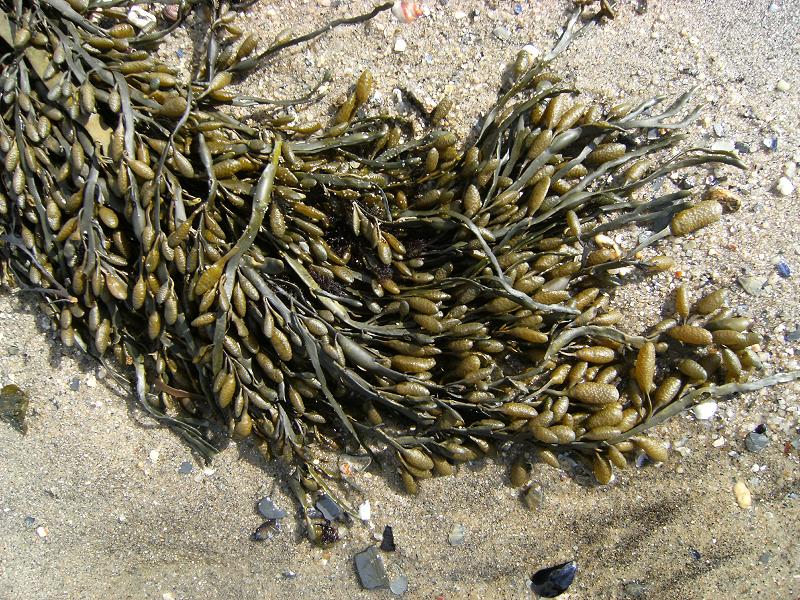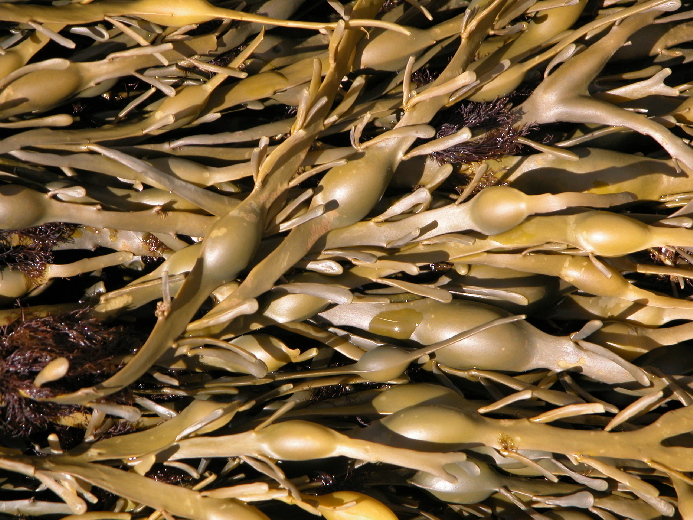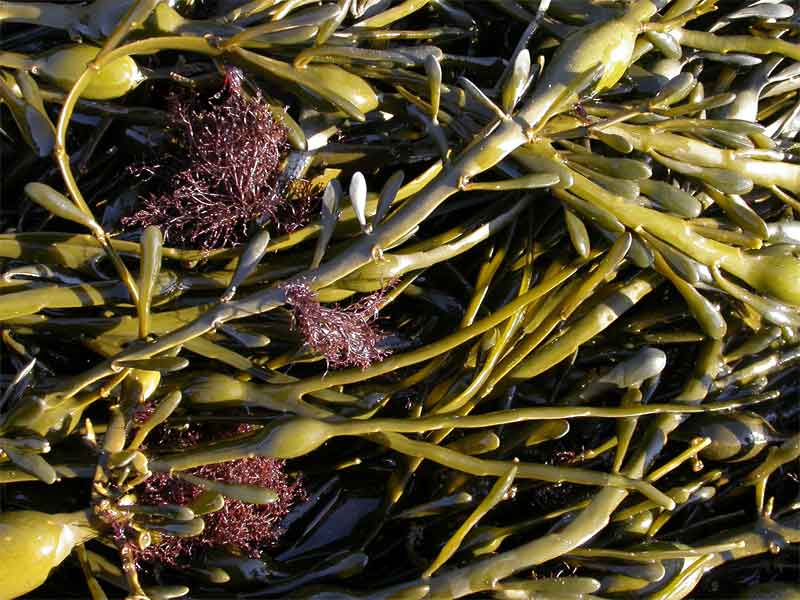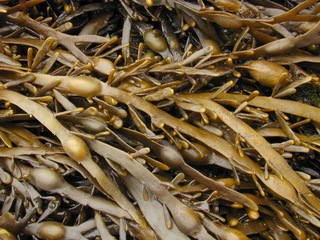Ascophyllum
Knotted ( Ascophyllum nodosum )
The Knotted ( Ascophyllum nodosum ) is a common species in the North Atlantic from the class of brown algae, which is also found in North Sea and Baltic Sea. It is used commercially for the production of alginic acid.
- 6.1 Notes and references
Description
The Knotted is a seaweed with a strong thallus, which reached a size of about 70 cm. From the holdfast, which anchors it to the solid surface, arise numerous long shoots, also can according to damage to the thallus it grow new shoots. They are loosely branched and prosper in almost regular intervals to swim bladders. In older specimens a new swim bladder is formed each spring, so that you can determine it 's age.
Reproduction
The Knotted is diploid and has no generational change. Triggered by shorter days result in the fall of the side of the main driving tufted short shoots. This mature during the winter and form at their ends club-shaped, yellowish fruit body ( seminal receptacles ). The gametes arise there in numerous pitcher -shaped countersunk Konzeptakeln. The Knotted is dioecious, so male and female gametes are produced via different thalli. In the spring, the eggs and sperm (swarm, zoospores ) are released into the water. The eggs but the pheromone Finnavarene from which attracts the sperm. In summer, the old fruiting bodies are thrown together with their stems.
Ecology
The red alga Vertebrata lanosa growing epiphytic as semi- parasite on the knotted.
Limpets of the genus Patella eat the thallus of Knotentangs and can push back its holdings until disappearance.
Occurrence
The Knotted is widespread in the North Atlantic subtropical to arctic zones in, he also grows on the coast of Brazil. Although he is occasionally also appeared in the Bay of San Francisco, he does not seem to occur permanently in the Pacific. In Europe, its range from the Canary Islands stretches as far as Spitzbergen and also includes the North Sea and Baltic Sea.
It occurs in the intertidal zone, where it grows in sheltered places rocks or walls. He usually can be found in the vertical zone below Spiraltang and above bladderwrack.
In Brittany, the holdings of the Knotentangs in the last 20 years have declined dramatically and in some places entirely disappeared. In Northern Ireland, a decrease is observed. The algae are eaten by mass occurrences of limpets. The cause of this population fluctuations or climate change are discussed.
System
The first description of Knotentangs was made in 1753 by Carl Linnaeus, under the name Fucus nodosus in Species plantarum, Volume 2, page 1159 Auguste -François Le Jolis presented the type 1863 in the genus Ascophyllum (In:. . Algues list of marines de Cherbourg Mémoires de la Societe Imperiale des Sciences Naturelles de Cherbourg 10, pp. 5-168 ). The Knotted is the only species of the genus Ascophyllum. It belongs to the family of Fucaceae within the order of the Fucales and is closely related to the genus Fucus.
Ascophyllum nodosum synonyms for (L.) Le Jolis are Ascophylla nodosa (L.) Kuntze, Fistularia nodosa (L.) Stackhouse, Fucodium nodosum (L.) J.Agardh, Fucus nodosus L., Halicoccus nodosus (L.) Lyngbye and Ozothallia nodosa (L.) Decaisne & Thuret. Furthermore, be regarded as synonymous: Ascophylla laevigatum Stackhouse, Ascophyllum mackayi ( Turner) Holmes & Batters, Ascophyllum mackayi f robertsonii Batters, Ascophyllum robertsonii ( Batters ) Batters, choir Daria scorpioides ( Hornemann ) Lyngbye, Fistularia mackayi ( Turner) Stackhouse, Fucodium nodosum var. scorpioides ( Hornemann ) J.Agardh, Fucus mackayi Turner, Fucus nodosus var denudatus C.Agardh, Fucus nodosus var evesiculosus J.Agardh, Fucus nodosus var siliquatus Turner, Fucus scorpioides Hornemann, Halicoccus nodosus var furcatus Areschoug, Halidrys siliquosa var minor Lyngbye, Ozothallia nodosa f furcata ( Areschoug ) Kjellman and Ozothallia vulgaris Decaisne & Thuret.
Use
The knotted is used for the recovery of alginic acid, which is used in the food industry and biotechnology. It is also used as fertilizer. Sustainable aquaculture is conducted in Norway, Ireland and Iceland. In Connemara (Ireland ) currently are about 30,000 t of hand harvested and transported to a drying factory.
The Tange also be used as a packaging material for haddock. When they are thrown into the sea at the destination, is short-lived populations can develop from.
Swell
- Michael Guiry: The Seaweed Site: information on marine algae: Ascophyllum nodosum accessed 14 February, 2013 ( sections description, occurrence, use)
- Michael D. Guiry, G. M. Guiry: Ascophyllum nodosum In: AlgaeBase - World -wide electronic publication, National University of Ireland, Galway accessed 20 March, 2012 ( section systematics, occurrence)
- P. Korn man P.H. Sahling: seaweed from Helgoland - Benthic green, brown and red algae. Biologische Anstalt Helgoland, Hamburg 1983, ISSN 0017-9957, p 168 ( section description)










